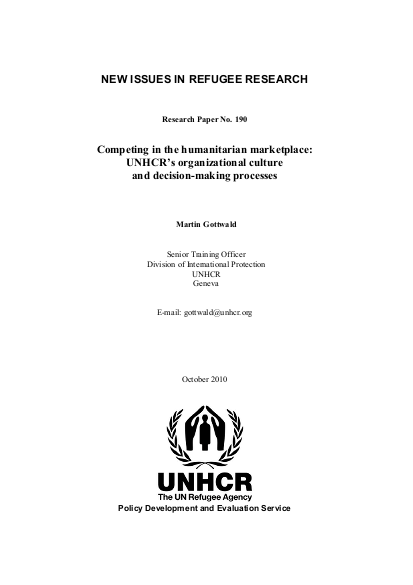
When the United Nations was created in 1945, a staffing structure was set up that presented a top-down, quasi-military command structure that was inspired by the League of Nations and the British concept of an independent civil service developed in the 19th century.1 Accordingly, when the UN General Assembly adopted on 14 December 1950 its resolution 428(V), enshrining the Statute of the Office of the United Nations High Commissioner for Refugees, its intention was to create - in line with the UN’s overall organizational structure - a vertical and centralized framework that vests the authority to protect refugees in the person of the High Commissioner for Refugees. Since the end of the Cold War, the humanitarian aid environment has turned into an increasingly complex and competitive marketplace. A significant number of humanitarian actors with different mandates and interests - including inter- governmental organizations, non-governmental organizations, private-sector organizations and military contingents - are engaged in humanitarian operations to protect and assist internally displaced persons in situations of civil conflict and natural disaster. They compete for limited and unpredictable funds from donor countries that pressure them for enhanced cost efficiency and greater collaboration. In response, UN agencies have started restructuring by decentralizing functions and responsibilities to field operations, and outsourcing tasks to external service providers. Furthermore, the international humanitarian community embarked in 2005 upon a major program of humanitarian reform. This reform process has included the creation of more predictable humanitarian financial arrangements, the strengthening of the Humanitarian Coordinator system to better support field coordination, and the establishment of the Cluster Approach. UNHCR was appointed Cluster Lead for Protection, Emergency Shelter, and Camp Coordination/Management. Today, its declared goal is to become the UN protection 2 agency for conflict and natural disasters. Such a leadership role requires not only cost-efficient organizational structures but also a decisive shift towards a greater external focus, a relational leadership orientation and a style that is flexible enough to adapt to different coordination situations and responds adequately to rapidly evolving circumstances. This paper examines the extent to which UNHCR’s organizational culture, structure, and processes need to change in order to adapt to the participative group processes introduced by the process of Humanitarian Reform and to apply effective leadership in the framework of the Cluster Approach. This paper uses decision-making as an example, which is a key process both within UNHCR and in the clusters, to illustrate the contrast between UNHCR’s internal environment and the ever-changing external humanitarian environment.
The paper first examines the relationship between UNHCR’s structures, processes and organizational culture. In particular it uses different models of corporate culture to assess how UNHCR’s vertical unconscious psychological values and assumptions impact on intra-organizational behavioural processes such as decision-making, communication and leadership behaviour. This includes investigating the extent to which lower and middle ranks of the organization are able to participate in internal decision-making processes and considering the skills and attitudes that are rewarded in UNHCR’s hierarchical day-to-day activities and the impact of these structures on efficiency, effectiveness and motivation. The second part of the paper compares UNHCR’s decision-making organizational culture with the demands and assumptions of the “horizontal” and “people oriented” decision-making culture that is developing externally as a result of Humanitarian Reform processes and the Cluster Approach. The difference between UNHCR’s “directive leadership” approach and the “facilitative leadership” approach, which has been called for as part of Humanitarian Reform, raises some important questions. To what extent, for example, do UNHCR’s current efforts to change organizational structure adequately prepare the organization for its envisaged role as “the UN protection agency” in the changing humanitarian environment? And what are the consequences if such reforms fail?